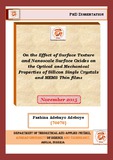| dc.description.abstract | This dissertation presents the combined results of analytical, computational and experimental study of the effects of surface texture and nanoscale surface oxides on the optical and mechanical properties of silicon single crystals and MEMS thin films. The first part of this work is focused on the analytical modeling of the reflectance of flat and textured silicon substrates. The model was used to study the reflection behavior of textured silicon surfaces under non-normal incidence. By characterizing the incident light and facets of the silicon wafer with vector geometry, dot products and Phong’s reflection model were used to determine the reflection angles between incident light rays and pyramidal facets. The possible optical interactions are considered for a wide range of pyramidal geometries and light incidence angles that are relevant to the exposure of textured silicon surfaces to incident
sunlight. Furthermore, the model was used to investigate the possibility of secondary reflection, for the full range of incidence angles to the substrate. The textured silicon surfaces were found to reduce the reflection angles more effectively than flat substrates at lower angles of incidence. Secondary reflection was also found to be experienced or guaranteed, for all pyramid heights, when the angle of incidence to the substrate was less than 19.4°. The
predictions are validated with experimental measurements of reflectance from (001)-textured silicon surfaces. Secondly, the results of an experimental study of the effects of surface texture on the optical and light trapping properties of silicon wafers are presented. Surface texture is controlled by anisotropy etching with potassium hydroxide (KOH) and isopropyl alcohol (IPA) solutions. The effects of KOH/IPA etching on the uniform distribution of
pyramidal textures on the (001)-oriented silicon wafer are elucidated. The effects of etchant concentration and KOH/IPA ratio are also explored, along with the effects of etching duration and temperature. The resulting surface morphologies are then characterized with atomic force microscopy and scanning electron microscopy. The optical reflectance associated with the different surface textures are also determined using surface profilometry and Ultra-Violet (UV)-visible spectroscopy. The results show that IPA concentration has the strongest effect on the surface roughness of (001)-single crystal crystals at temperatures up to 80oC. Abovethis value, evidence of temperature-induced cracking was revealed on the silicon substrate.
The best volume concentration ratio of KOH: IPA is also found to be 2:4. In an effort to ascertain the effectiveness of the texturing process for light trapping scheme, simple 1 x 1 cm2 solar cell devices with the structure of ITO/p-Si/Al were fabricated on both textured and flat silicon wafers. Finally, analytical and computational models for the study of fatigue crack nucleation in silicon micro-electro-mechanical systems (MEMS) structures are presented.
Finite element modeling is used to study the role of stress-assisted dissolution on the formation and growth of cracks in the topical SiO2 layer on the silicon MEMS structures. The possible formation and growth of cracks by such dissolution is elucidated and compared with measured surface profiles from prior work using Atomic Force Microscopy (AFM). The experimental results are also compared with predictions from linear perturbation analysis of the stability of surface topology that evolves during stress-assisted dissolution of the silica layer. The implications of the results are then discussed for the development of micro-pyramids for light trapping and improved photo-conversion in silicon solar cells and the design of reliable Si-MEMS structures. | en_US |

